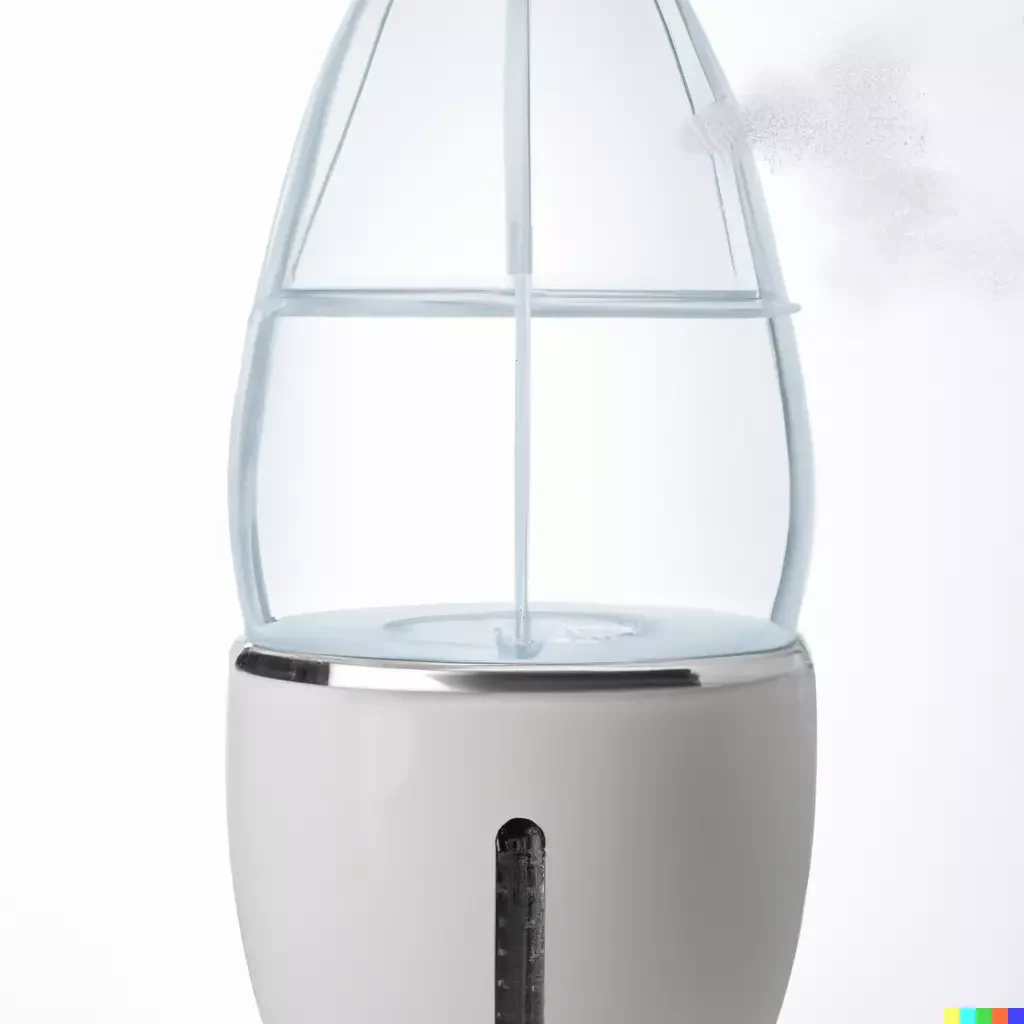Humidifying oxygen is a process of adding moisture to oxygen before inhalation. It helps prevent dryness in the airways and lungs.
Humidification is essential, especially when oxygen is delivered at high flow rates, as it can cause the respiratory passages to dry out, leading to discomfort and potential tissue damage. Patients who require supplemental oxygen, such as those with COPD or other chronic respiratory conditions, often benefit from a humidification system.
Medical professionals usually recommend this practice to improve comfort and therapy effectiveness. Humidifiers can be added to stationary and portable oxygen concentrators, ensuring that oxygen therapy remains both soothing and beneficial. Proper humidification also assists in maintaining mucociliary function, which is crucial for protecting the respiratory system from infection and clearing secretions.
Breathing Basics And The Role Of Humidity
Our lungs love moisture. Dry air can make breathing less comfortable. But with the right humidity, our airways stay happy. Let’s dive into how this works!
The Science Of Respiration
When we inhale, air travels down our windpipe. It reaches tiny air sacs in our lungs. Here, oxygen enters our blood. To do this well, those tiny sacs need a certain amount of moisture. Dry air can irritate our airways. It makes it harder for oxygen to enter our blood.
| Step | Process | What Helps |
|---|---|---|
| 1 | Inhale Air | Moist airways |
| 2 | Air Reaches Lungs | Healthy humidity |
| 3 | Oxygen Transfer | Proper hydration |
As the table shows, humidity helps in each step. From inhalation to oxygen transfer, moisture is key.
How Humidity Affects Lung Function
Humid air can feel easier to breathe. It helps keep the mucus lining our airways thin. This makes it easier to cough out unwanted particles. On the other hand, dry air can thicken this mucus. It can make us more prone to coughing and discomfort.
- Thin mucus: Eases breathing
- Dry air: Makes mucus thick
- Proper humidity: Reduces cough risk
Humidified oxygen is often used in hospitals. It helps patients breathe better. This is because adding moisture to oxygen helps it move through airways smoothly. When our throat and nasal passages are moist, oxygen can flow without irritation.
- Moist air soothes the throat.
- It calms nasal passages.
- Breathing becomes smoother.
Good humidity levels keep our lungs working well. They help us avoid respiratory issues. They ensure we get enough oxygen with every breath.

Credit: www.amazon.com
Humidify Oxygen: The Therapeutic Approach
Oxygen therapy plays a crucial role in treating various medical conditions. But did you know that it’s not just about the oxygen itself? The trick lies in its delivery. Our bodies thrive on the humidified oxygen that mirrors the natural, moist air we breathe every day. This approach ensures the therapeutic effects of oxygen therapy are maximized for patient comfort and health.
The Need For Humidified Oxygen
Oxygen can dry out the airways if not properly humidified. When it’s too dry, it can cause discomfort and potential harm. Here’s why doctors often recommend humidified oxygen:
- Protects mucous membranes: Dry oxygen can irritate the delicate tissue inside the nose and throat.
- Prevents secretions: Humidity keeps the mucus thin so it can clear the airways.
- Enhances comfort: Moist air is soothing when taking deep breaths, especially with a nasal cannula or mask.
- Improves oxygen absorption: Humid air can help the lungs absorb oxygen more effectively.
Methods Of Humidifying Oxygen
Several techniques help add moisture to oxygen before it enters the body:
- Bubble humidifiers: Oxygen bubbles through water to pick up moisture.
- Passover humidifiers: Oxygen flows over a water surface, becoming humidified.
- Vaporizers: Electric vaporizers heat water into steam that mixes with the oxygen.
- Heat moisture exchangers (HME): Use exhaled air to moisten the incoming oxygen.
Each method has its place depending on the user’s needs and the care setting. For instance, home users might prefer simple bubble humidifiers, while hospitals might choose advanced vaporizers for precise humidity control.
| Method | Setting | Moisture Level |
|---|---|---|
| Bubble Humidifiers | Home | Basic |
| Passover Humidifiers | Clinical | Moderate |
| Vaporizers | Hospital | High |
| HME | Various | Variable |
Remember, using the correct humidifying method depends on individual requirements and medical advice. Consult with a healthcare professional before deciding on a humidification system for oxygen therapy.
Benefits Of Moisture-rich Air For Respiratory Health
Moisture in the air plays a crucial role in maintaining respiratory health. Dry air can lead to irritation in the airways, but humidity offers a soothing blanket of moisture. This keeps the lungs comfortable and breathing easy. Let’s delve into how humidified oxygen can elevate our respiratory well-being.
Easing respiratory conditionsEasing Respiratory Conditions
When the air is dry, our airways can become irritated. Viruses and bacteria thrive in such an environment. Moisture-rich air helps to maintain the natural defenses of our airways. It can ease symptoms in conditions like:
- Asthma: Reduces irritation caused by dry air
- Bronchitis: Soothes inflamed bronchial tubes
- Cold and flu: Promotes recovery by keeping mucus thin
Humidified oxygen also helps by keeping cilia in our nose and respiratory tract working effectively. These tiny hairs filter out germs and dust from the air we breathe.
Enhancing comfort and breathingEnhancing Comfort And Breathing
Moist air makes breathing easier. It’s like a gentle, soothing balm for our airways. With the right humidity levels, we experience:
- Reduced snoring, as airways are less restricted
- Better sleep, with air that is comfortable to breathe
- Improved well-being, from infants to the elderly
It’s essential to maintain humidity at optimal levels. Too much humidity can also lead to problems. A range of 40-60% is generally considered the sweet spot for indoor air quality.
Inhalation Devices And Systems
When we talk about humidified oxygen therapy, it’s crucial to shed light on the various inhalation devices and systems available. These systems ensure that patients receive moisture-rich oxygen. Good moisture levels prevent dryness in the airways. This enhances comfort and improves therapy efficiency. The correct device can make a huge difference in a patient’s quality of life.
Types Of Humidifiers
Several types of humidifiers work with inhalation devices. Each has its benefits. Let’s explore them.
- Passover Humidifiers: Simple designs. They direct the oxygen over water, picking up moisture.
- Bubble Humidifiers: Oxygen forms bubbles in the water. This method adds humidity.
- Heat Moisture Exchangers (HME): These capture exhaled moisture. They heat to add it to the inhaled air.
- Heated Humidifiers: They warm water before mixing with oxygen. This provides higher levels of humidity.
Maintaining And Cleaning Your Device
Keeping your inhalation device in top shape is where longevity and performance meet. A well-maintained device offers safe, hygienic therapy. Here are simple steps to follow:
- Daily Rinsing: Rinse the humidifier with warm water every day.
- Regular Disinfecting: At least once a week, disinfect using a mixture of water and vinegar.
- Changing the Water: Never let water sit in a humidifier for too long. Change it as per the manufacturer’s guidelines.
By following these steps, you can ensure that your device remains clean and functional.
Remember, always consult the device manual for specific instructions. Different brands may have varied care processes.
Regular maintenance avoids the build-up of minerals and bacteria. This is vital for patient safety. It also maximizes device efficiency.
Personal Stories: Improved Quality Of Life
Welcome to a heartwarming chapter of our health journey diary:
Oxygen therapy transforms lives every day.
Here, we explore personal encounters with humidify oxygen therapy.
Breathe in these true accounts of revitalized wellness.
Testimonials From Patients
Revelations from real users of humidified oxygen therapy share its impact.
| Name | Experience |
|---|---|
| Emma | “It chased away my headaches. My sleep improved vastly.” |
| Liam | “Breath-taking change. My energy levels soared!” |
| Sophia | “Dry throat gone. My mornings feel fresh!” |
Expert Insights On Humidified Air Therapy
Leading medical voices endorse humidified air for enhanced oxygen therapy.
- Dr. Smith: “It promotes mucosal hydration, key for lung health.”
- Prof. Jones: “Humidity eases oxygen absorption. Patients feel the difference.”
- Dr. Lee: “Consistent results in patient comfort and sleep quality improvement.”

Credit: www.amazon.com
Navigating The Challenges
Humidify Oxygen presents unique obstacles for both users and providers. Maintaining optimal humidity levels is crucial for comfort and health. Users often encounter hurdles that could compromise the effectiveness of oxygen therapy. Recognizing and overcoming these challenges ensures better outcomes.
Common Issues With Humidity Levels
Incorrect humidity causes discomfort. Dry air might lead to a sore throat. Too much moisture invites bacteria. Both affect oxygen therapy quality. Patients feel the impact of these conditions, which might discourage consistent use.
- Variable weather – Outdoor conditions influence indoor humidity.
- Device limitations – Not all humidifiers adjust automatically.
- Maintenance needs – Regular care ensures proper function.
Solutions For Consistent Humidity
Reliable humidity is key to effective Humidify Oxygen therapy. Tailored solutions promote comfort and health. Here are proven strategies:
| Problem | Solution |
|---|---|
| Fluctuating humidity | Use a hygrometer. It measures moisture levels. |
| Limited device adjustability | Choose smart humidifiers. They adapt to needs. |
| Frequent maintenance | Follow a cleaning schedule. It helps performance. |
Following these steps ensures therapy success. Reliable devices and practices make management straightforward. Take control of your environment for the best oxygen therapy experience.

Credit: thegadgetflow.com
Frequently Asked Questions On Humidify Oxygen
What Is Humidifying Oxygen?
Humidifying oxygen refers to adding moisture to the oxygen delivered to patients during therapy, preventing dryness in the airways.
Is Humidified Oxygen Better?
Humidified oxygen can be better for preventing dryness in the nasal passages, throat, and mouth, especially during long-term oxygen therapy. This added moisture helps ensure comfort and maintains mucous membrane integrity. Always consult a healthcare provider for personalized medical advice.
When Should You Humidify Oxygen?
Humidify oxygen when providing supplemental O2 for prolonged periods, treating dry or bloody noses, sore throats, or to soothe irritated respiratory tracts. Consider humidification for patients with artificial airways.
Can A Humidifier Help With Oxygen?
A humidifier does not directly increase oxygen levels; it adds moisture to the air which can aid in easier breathing.
Conclusion
Understanding the nuances of humidifying oxygen is key to maintaining overall health, particularly for those with respiratory issues. We’ve explored the benefits, options, and best practices to ensure you’re equipped with the knowledge for a better breathing environment. Remember, a well-humidified space can mean the difference between comfort and discomfort.
Embrace the journey towards cleaner, more comfortable air today.




